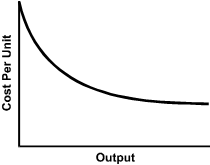Recommendation for individuals using a screenreader: please set your punctuation settings to "most."
Descriptive Statements:
- Recognize basic economic concepts, including scarcity, opportunity cost, economic incentives, competition, specialization, marginal utility, elasticity, economies of scale, and the law of diminishing returns.
- Compare basic characteristics of market, traditional, command, and mixed economic systems.
- Demonstrate knowledge of the factors of production (i.e., land, labor, capital, and entrepreneurship) and how they are combined to produce goods and services.
- Analyze how the laws of supply and demand, prices, and various competitive models (e.g., oligopoly, monopolistic competition) function in a market economy.
- Interpret economic information presented in various visual formats, including supply and demand charts, price indexes, circular flowcharts, and production possibility curves.
- Analyze factors affecting the operation of business firms, including basic forms of business organization; decision-making and information-gathering methods; strategies for allocating scarce resources; and production, marketing, and distribution considerations.
- Recognize basic principles of consumer economics, including purchasing options for goods and services, sources of consumer information, types of consumer marketing and advertising, and consumer protection laws.
- Demonstrate knowledge of basic principles of personal finance, including principles of budgeting, different forms of credit, and savings and investment options.
Sample Item:

The curve starts at a point at the top of the vertical axis and at 0 on the horizontal axis. It curves steeply downward for about a third of the way down the vertical axis and a quarter of the way along the horizontal axis. It then curves more gradually until about 2 thirds of the way down the vertical axis and halfway along the horizontal axis, at which point it comes close to staying parallel with the horizontal axis.
The cost curve above best illustrates which of the following economic concepts?
- economies of scale
- elasticity of supply
- return to capital
- law of diminishing returns
Correct Response and Explanation (Show Correct ResponseHide Correct Response)
A. This question requires the examinee to analyze basic economic terms and concepts. Economies of scale are productive activities in which the cost per unit declines as output increases, as illustrated in the diagram.
Descriptive Statements:
- Demonstrate knowledge of the roles of and relationships between major economic institutions and groups in the U.S. economic system, including banks, financial markets, labor unions, corporations, and consumers.
- Analyze the causes and effects of unemployment, inflation, and deflation, including different types of unemployment and inflation, the effects of inflation and deflation on different groups, and ways in which unemployment and inflation are calculated.
- Demonstrate knowledge of the stages of the business cycle (i.e., expansion, peak, contraction, and trough) and factors influencing movement among the four stages.
- Examine factors influencing fiscal policy, including major areas of government revenues and expenditures, the effects of surpluses and deficits on the economy, demand-side vs. supply-side theories, and the likely response of fiscal policymakers to given economic developments.
- Analyze factors influencing monetary policy, including the structure and functions of the Federal Reserve System, basic tools of monetary policy, monetarist theory, and the likely response of the Federal Reserve to given economic developments.
- Demonstrate knowledge of forms of government regulation and their effects on consumers and producers.
- Examine the basic principles and components of international economics, including the concepts of absolute and comparative advantage, the principles of free trade and protectionism, economic development strategies, and major patterns of economic exchange.
- Analyze factors influencing the operation of the international economic system, including exchange rates, trade restrictions, the balance of payments, and the policies of international economic agencies such as the World Bank, International Monetary Fund, and World Trade Organization.
Sample Item:
- Inflationary pressures intensify.
- Finding new workers becomes increasingly difficult.
- Interest rates increase.
- Demand begins to overtake supply.
During which phase of the business cycle is an economy most likely to experience the developments
described in the list above?
- expansion
- peak
- contraction
- trough
Correct Response and Explanation (Show Correct ResponseHide Correct Response)
B. This question requires the examinee to analyze factors influencing the business cycle.
As the economy nears full production during the peak phase of a business cycle, consumer demand becomes
greater than companies are able to supply, most workers are already employed, and the demand for bank loans
to fuel greater production drives up interest rates. Together, these factors begin to drive prices higher,
initiating an inflationary spiral.

